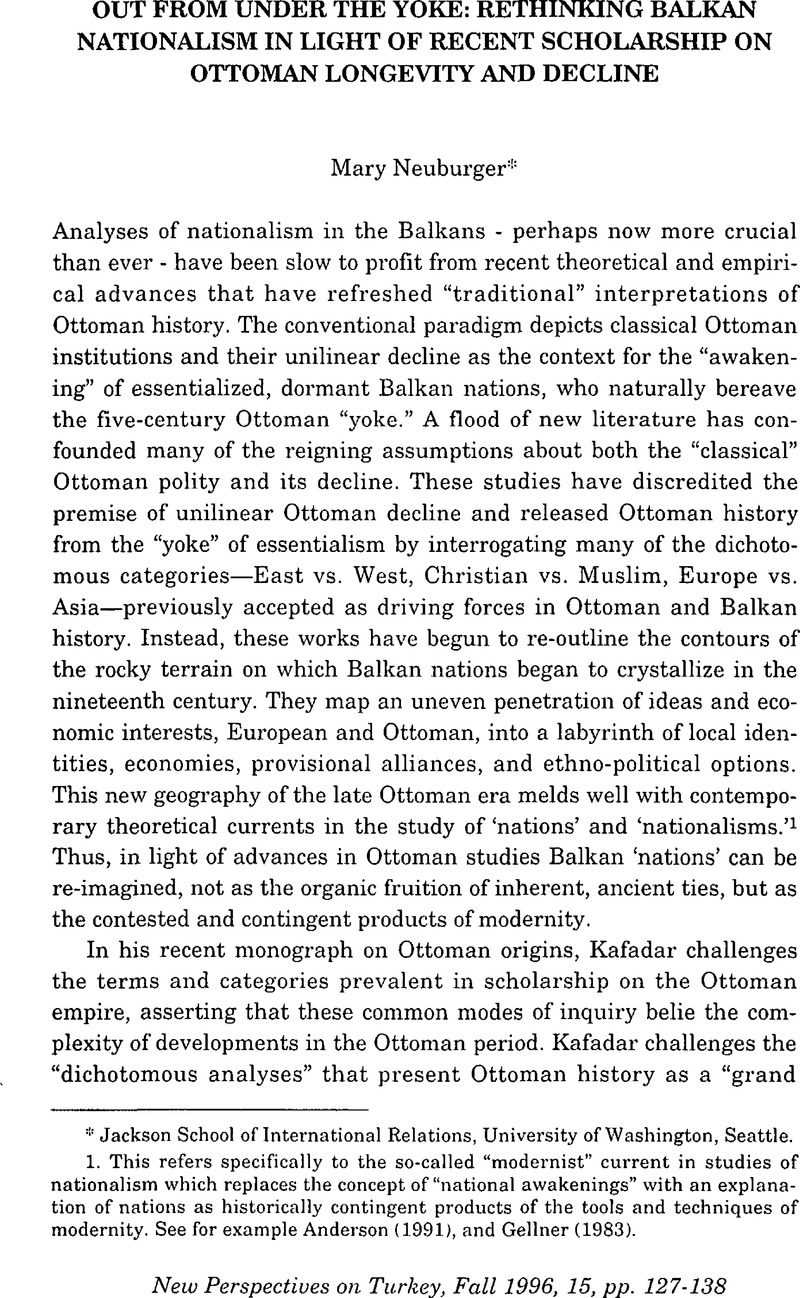No CrossRef data available.
Article contents
Out From Under the Yoke: Rethinking Balkan Nationalism in Light of Recent Scholarship on Ottoman Longevity and Decline
Published online by Cambridge University Press: 21 July 2015
Abstract
An abstract is not available for this content so a preview has been provided. Please use the Get access link above for information on how to access this content.

- Type
- Review Articles
- Information
- Copyright
- Copyright © New Perspectives on Turkey 1996
References
Adanır, F. 1989. “Traditional and Rural Change in Southeastern Europe under Ottoman Rule,” in Chirot, D., (ed.) Origins of Backwardness in Eastern Europe: Economics and Politics from the Middle Ages Until the Early Twentieth Century. Berkeley: University of California Press, pp. 131–177.Google Scholar
Anderson, B. 1991. Imagined Communities: Reflections on the Origin and Spread of Nationalism, London: Verso.Google Scholar
Braude, B. and Lewis, B. (eds). 1982. Christians and Jews in the Ottoman Empire: The Functioning of a Plural Society. 2 vol., New York: Holmes and Meier Inc.Google Scholar
Faroqhi, S. 1987. Men of Modest Substance: House Owners and ‘House Property in Seventeenth Century Ankara and Kayseri. Cambridge: Cambridge University Press.CrossRefGoogle Scholar
Faroqhi, S 1994. “Part II: Crisis and Change, 1590-1699,” in Inalcik, H., and Quataert, D., Donald, (eds). An Economic and Social History of the Ottoman Empire, 1300-114. Cambridge: Cambridge University Press, p. 411–623.Google Scholar
Findley, C. 1989. Ottoman Civil Officialdom: A Social History. Princeton, NJ: Princeton University Press.CrossRefGoogle Scholar
Fleischer, C. 1986. Bureaucrat and Intellectual in the Ottoman Empire: The Historian Mustafa Ali (1541-1600). Princeton, NJ: Princeton University Press.CrossRefGoogle Scholar
Goffman, D. 1990. Izmir and the Levantine World, 1550-1650. Seattle: University of Washington.Google Scholar
Goffman, D 1994. “Ottoman Millets in the Early Seventeenth Century,” New Perspectives on Turkey. 11:135-59, Fall.Google Scholar
İnalcık, H. and Quataert, D. (eds.). 1994. An Economic and social history of the Ottoman Empire, 1300-114. Cambridge: Cambridge University Press.Google Scholar
İslamoğlu-İnan, H. (ed.). 1987. The Ottoman Empire and the World Economy. Cambridge: Cambridge University Press.Google Scholar
Jelavich, B. and C. 1987. The Establishment of Balkan National States 1804-1920. Seattle: University of Washington Press.Google Scholar
Jelavich, B 1977. The Establishment of Balkan National States 1804-1920. Seattle: University of Washington Press.Google Scholar
Kafadar, C. 1995. Between Two Worlds: The Construction of the Ottoman State. Berkeley: University of California Press.Google Scholar
Karpat, K. 1973. An Inquiry into the Social Foundations of Nationalism in the Ottoman State: From Social Estates to Classes, from Millets to Nations. Princeton, NJ: Center of International Studies, Princeton University.Google Scholar
Kasaba, R. 1988. The Ottoman Empire and the World Economy: The Nineteenth Century. Albany: State University of New York Press.Google Scholar
Keyder, Ç., Özveren, E., and Quataert, D. (eds.). 1993. Port Cities of the Eastern Mediterranean, 1800-1914, special issue, Review, 16, 4, Fall.Google Scholar
Lampe, J. 1989. “Imperial Borderlands or Capitalist Periphery? Redefining Balkan Backwardness, 1520-1914,” in Chirot, D. (ed.), Origins of Backwardness in Eastern Europe: Economics and Politics from the Middle Ages Until the Early Twentieth Century. Berkeley: University of California Press, pp. 177–210.Google Scholar
McGowan, B. 1987. Economic Life in the Ottoman Empire: Taxation Trade and the Struggle for Land 1600-1800. Cambridge: Cambridge University Press.Google Scholar
Peirce, L. 1993. The Imperial Harem: Women and Sovereignty in the Ottoman Empire. Oxford: Oxford University Press.CrossRefGoogle Scholar
Quataert, D. 1994. “Part IV: The Age of Reform,” in Inalcik, H. and Quataert, D., Donald, (eds). An Economic and Social History of the Ottoman Empire, 1300-114. Cambridge: Cambridge University Press, pp. 759–934.Google Scholar
Stoianovich, T. 1960. “The Conquering Balkan Orthodox Merchants.” Journal of Economic History. 20, 2, pp. 234–313.CrossRefGoogle Scholar
Sugar, P. 1977. Southeastern Europe under Ottoman Rule 1354-1804. Seattle: University of Washington Press.Google Scholar
Todorova, M. 1994. “The Balkans: From Discovery to Invention.” Slavic Review 53, 2: 451–482, Summer.CrossRefGoogle Scholar
Wallerstein, I. 1977. The Modern World System: Capitalist Agriculture and the Origins of the European World Economy in the Sixteenth Century. New York: Academic Press.Google Scholar




